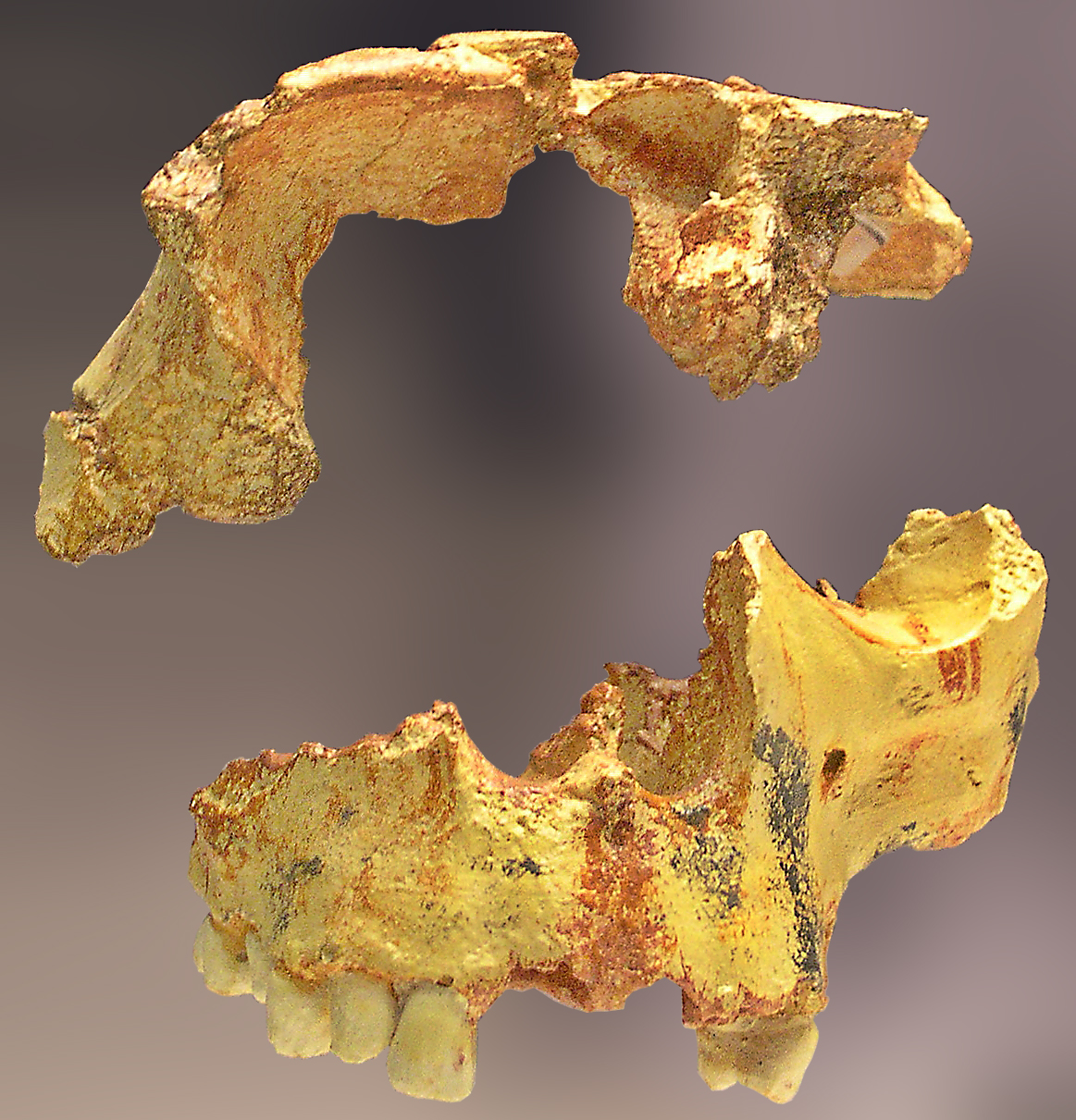- Homo antecessor
Taxobox | name = "Homo antecessor"
fossil_range =Early Pleistocene

image_width = 200px
regnum =Animal ia
phylum =Chordata
classis =Mammal ia
ordo =Primate s
familia = Hominidae
subfamilia =Homininae
genus = "Homo"
species = "H. antecessor"
binomial = †"Homo antecessor"
binomial_authority = Bermudez de Castro "et al.", 1997"Homo antecessor" is an extinct
hominin and a potential distinct species dating from 1.2 million to 800,000 years ago, that was discovered byEudald Carbonell , J. L. Arsuaga and J. M. Bermúdez de Castro. "H. antecessor" is one of the earliest known hominins inEurope ; only those individuals from the site ofDmanisi , Georgia, are older. Many anthropologists believe that "H. antecessor" is either the same species or a direct antecedent to "Homo heidelbergensis ", who inhabited Europe from 600,000 to 250,000 years ago in thePleistocene . It is suggested that this is the last common ancestor of "Homo neanderthalensis" and "Homo sapiens".The best-preserved fossil is a
maxilla which belonged to a 10-year-old individual found inSpain . Based on palaeomagnetic measurements, it is thought to be older than 780-857 ka (Falguères "et al.", 1999:351). The average brain was 1000 cm³ in volume. In 1994 and 1995, 80 fossils of six individuals that may have belonged to the species were found inAtapuerca . At the site were numerous examples of cuts where the flesh had been flensed from the bones, which indicates that "H. antecessor" could have practisedcannibalism . [cite journal
author = Fernández-Jalvo, Y.; Díez, J. C.; Cáceres, I. and Rosell, J.
title = Human cannibalism in the Early Pleistocene of Europe (Gran Dolina, Sierra de Atapuerca, Burgos, Spain)
journal = Journal of Human Evolution
volume = 37
issue = 34
pages = 591–622
date = September 1999
publisher =Academic Press
issn = 0047-2484
doi = 10.1006/jhev.1999.0324 ]Physiology
"Homo antecessor" was about 1.6-1.8 m (5½-6) feet tall, and males weighed roughly 90 kg (200 pounds). Their brain sizes were roughly 1000-1150 cm³, smaller than the 1350 cm³ average of modern humans. Due to its scarcity, very little more is known about the physiology of "H. antecessor", yet it was likely to have been more robust than "H. heidelbergensis". According to Juan Luis Arsuaga, one of the co-directors of the excavation in Burgos, "H. antecessor" might have been right-handed, a trait that makes him different from the rest of apes. The hypothesis is based on
tomography techniques. Arsuaga also claims that the frequency range of audition is similar to "H. sapiens"' which makes him believe that "H. antecessor" used a symbolic language and was able to reason. [ [http://www.elmundo.es/elmundo/2006/09/18/ciencia/1158569199.html El Mundo newspaper] (in Spanish)] Arsuaga's team is currently pursuing a DNA map of "H. antecessor" after elucidating that of a bear that lived in northern Spain some 500,000 years ago.Basing on teeth eruption pattern, the researchers think that "Homo antecessor" had the same development stages as "Homo sapiens", though probably at a faster pace. Other features acquired by the species are a protruding
occipital bun , a low forehead and a lack of a chin. Some of the remains are almost indistinguishable from the fossil attributable to KNM-WT 15000 (Turkana Boy ) belonging to "Homo ergaster ".Fossil sites
The only known fossils of "H. antecessor" are from two sites in the Sierra de Atapuerca region of northern Spain (Gran Dolina and Sima del Elefante).
Gran Dolina
Archaeologist Eudald Carbonell i Roura of the Universidad Rovira i Virgili in
Tarragona ,Spain and palaeoanthropologist Juan Luis Arsuaga Ferreras of theComplutense University of Madrid discovered "Homo antecessor" remains at the Gran Dolina site in the Sierra deAtapuerca , east ofBurgos . The "H. antecessor" remains have been found in level 6 (TF6) of the Gran Dolina site . Over 80 bone fragments from six individuals were uncovered in 1994 and 1995. The site had also included roughly 200 stone tools and about 300 animal bones. Stone tools including a stone carved knife were found along with the ancient hominin remains. All these remains were dated at least 780,000 years old. The best-preserved remains are amaxilla (upper jawbone) and afrontal bone of an individual who died at 10-11 years old.ima del Elefante
On
2007-06-29 , Spanish researchers working at the Sima del Elefante site announced that they had recovered a molar dated to 1.1–1.2 million years ago. The molar was described as "well worn" and from an individual between 20 and 25 years of age. Additional findings announced on2008-03-27 included the discovery of amandible fragment, stone flakes, and evidence of animal bone processing. [cite journal
last = Carbonell
first = Eudald
authorlink = Eudald Carbonell
coauthors = José M. Bermúdez de Castro "et al"
title = The first hominin of Europe
journal = Nature
volume = 452
issue =
pages = 465–469
date =2008-03-27
publisher =
doi = 10.1038/nature06815
accessdate = 2008-03-26
url = http://www.nature.com/nature/journal/v452/n7186/full/nature06815.html ]References
*
BBC - "Dawn of Man" (2000) by Robin Mckie ISBN 0-7894-6262-1
* [http://www.jqjacobs.net/anthro/paleo/antecessor.html Homo antecessor]
* [http://www.mnh.si.edu/anthro/humanorigins/ha/a_tree.html rly Human Phylogeny]
Wikimedia Foundation. 2010.
